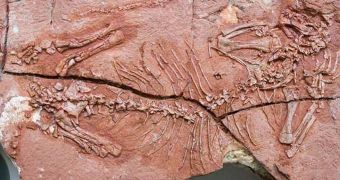In an age when dinosaurs were still unheard of, animals living at the middle of the food chain had to adapt to being hunted down and killed by just about everyone else. And seeing how the largest and vicious predators owned the land, these animals turned to trees. The plants offered a rich source of food, and also provided the climbers with safety from attacks. Experts have recently revealed that the animal known as Suminia getmanovi is the oldest such creature discovered until now on the planet, estimated to have lived around 250 million years ago.
LiveScience reports that the dozen Suminia skeletons that were discovered in the Kirov region of what is now central Russia, in 1990, were formed about 30 million years before the appearance of the first dinosaurs. Studies have also revealed that the animals spanned a period of time that ended with the Late Paleozoic. All of the skeletons were found in a single large block of red mudstone, hinting at the fact that these were social creatures.
“It's relatively rare to find several animals locked on a single block. We have examples of virtually every bone in their bodies,” Paleontologist Jorg Frobisch, from the Field Museum of Chicago, says. The expert has been the leader of the new research effort, which has also included University of Toronto scientist Robert Reisz. Details of their finds appear in the July 29th issue of the scientific journal Proceedings of the Royal Society B.
The Suminia had very peculiar hands, sporting elongated fingers and opposable thumb-like formations, as well as curbed claws and a grasping tail. The animal was an herbivore, which would explain why it decided to move into the trees at some point, where sufficient amounts of leaves to sustain considerable populations were available. The “vegetarian” also developed huge eyes – as compared with its body – which were most likely an adaptation to its new environment, and might imply a nocturnal lifestyle.
“The first ecosystems on land were very different from modern terrestrial ecosystems. You had a lot of predatory animals, a lot of meat-eaters, and while plant-eating lifestyles evolved several times, they weren't dominant. But then you saw a humongous shift, from lots of carnivores and relatively few herbivores to lots of herbivores and few carnivores – the evolution of modern types of terrestrial ecosystems. So this shift in what food is eaten all of a sudden increases competition for plant food resources, and shortly after this shift, you see Suminia invade this ecological space for the first time,” Frobisch adds.

 14 DAY TRIAL //
14 DAY TRIAL //